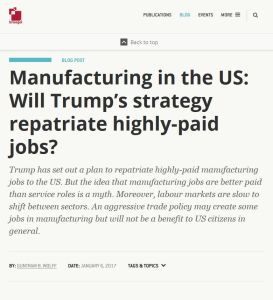
Guntram B. Wolff
Manufacturing in the US
Will Trump’s Strategy Repatriate Highly Paid Jobs?
Bruegel, 2017
What's inside?
Repatriating manufacturing to the United States may do more harm than good.
Recommendation
Bringing good-paying manufacturing jobs back to the United States by restructuring its trade deals with other countries ranks high on President Trump’s priority list. Such rhetoric has strong emotional appeal, but Guntram B. Wolff, head of the European think tank Bruegel, explains how revamped trade policies may do more harm than good to American workers. While always politically neutral, getAbstract suggests this concise economic overview to anyone interested in the potentially unintended economic consequences of political promises.
Take-Aways
- One of President Donald Trump’s 2016 campaign promises was to bring well-paid manufacturing jobs back to the United States.
- His administration’s main claim is that, by relocating factories to other countries, US manufacturers have widened the trade deficit, destroyed good-paying manufacturing jobs and left workers to take lower-paying service sector positions.
- Technology has been a major factor behind the decline in manufacturing jobs globally.
- In 2016, service jobs in some sectors paid 80 cents an hour more, on average, than nonsupervisory manufacturing jobs.
- If there is any argument against recent trade policy, it is that international trade opened up too fast for labor markets to adjust.
Summary
One of US president Donald Trump’s campaign promises was to bring well-paid manufacturing jobs back to the United States by reworking international trade agreements. Peter Navarro and Wilbur Ross, two major figures in the Trump administration, advocated an economic vision to accomplish this in a paper posted to the campaign’s website in September 2016. The main claim made by Navarro and Ross is that by relocating factories to other countries, US manufacturers widened the trade deficit, destroyed good-paying manufacturing jobs and left workers to take lower-paying service sector positions.
“Technological progress has been a major driver of losses in manufacturing jobs in the US and elsewhere.”
It’s true that trade policy affects manufacturing jobs. Yet technology has been a major factor in the global decline of manufacturing jobs. And the assertion that service sector jobs are lower paid “is a myth”: Nonsupervisory manufacturing workers’ average hourly wages haven’t kept up with those of employees in sectors such as information, mining and logging, finance, construction, professional and business services, and education and health care. Service jobs, on average, paid 80 cents per hour more than manufacturing jobs in 2016.
“If the US were not to impose tariffs on foreign competitors,…the price of Fords produced at American wage levels would be higher than those of Volkswagens produced at Mexican wage levels.”
Returning manufacturing to the United States can happen with or without protectionist tariffs. In the latter case, domestically produced items would be more expensive because of the higher wages US companies offer compared to those of firms located in less costly countries. American consumers would then prefer to purchase the lower-priced foreign-made alternatives. Reduced US sales would inevitably lead to US job losses. If Trump imposes tariffs, as he has promised, Americans would have no choice but to pay more for many US-made products. Manufacturing wage levels might increase temporarily but would likely drift down as competition for those jobs rose. In the meantime, Americans bearing the brunt of higher prices would spend less on services. Service-sector workers, who might seek increased pay in manufacturing, could not readily acquire the necessary skills: “A server cannot leave the restaurant on Friday and start to build cars on Monday.” And retaliation by US trade partners could put a severe dent in the businesses of US exporters.
“It is still hard to see how putting up barriers after the fact would be a winning policy for Trump’s America.”
If there is any argument against recent trade policy, it is that international trade opened up too fast for labor markets to adjust. Nonetheless, the idea of bringing manufacturing jobs to the United States through protectionist policies “looks like a losing proposition.”
About the Author
Guntram B. Wolff is the director of Bruegel, a European think tank.
This document is restricted to personal use only.
My Highlights
Did you like this summary?
Read the articleThis summary has been shared with you by getAbstract.
We find, rate and summarize relevant knowledge to help people make better decisions in business and in their private lives.
Already a customer? Log in here.

























Comment on this summary